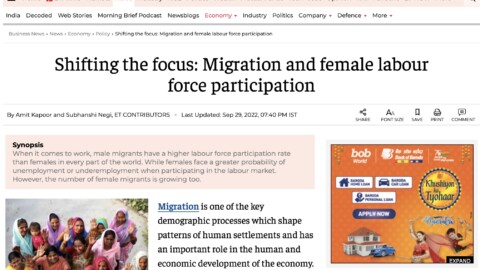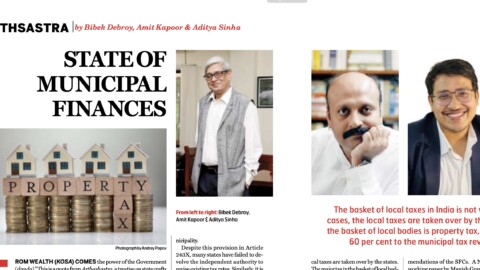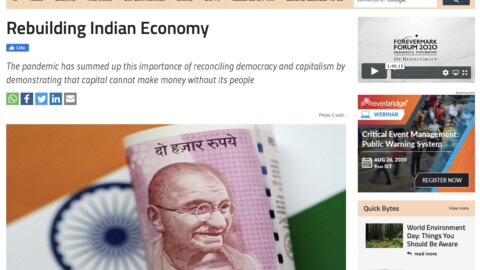By Amit Kapoor and Inputs by Sheen Zutshi
In many parts of the world, convergence theory is the prevailing trend, with developing economies experiencing faster growth and gradually catching up to their wealthier counterparts. As posited in growth theory, this convergence trend is not unique and usually applies to regions that typically begin with low-performance levels on an important outcome, such as GDP or GDP per capita income.
The global literature on convergence theory suggests that these regions should experience quicker growth on that outcome over time, increasing their performance to catch up with regions that began with higher starting points. β-convergence is a form of convergence that suggests that poorer regions are growing faster than richer ones. However, when we look at Indian states, especially those in the eastern region, we find that despite their vast mineral wealth and strategic locational advantages, the states in the eastern region remain economically underdeveloped compared to other regions in India. This is a pressing situation that demands immediate attention and action. It further underscores the urgent need for immediate and decisive state governmental interventions to stimulate economic growth and development in the lagging region.
In the fiscal year 2022–23, the combined GDP of the eastern region was approximately $578.98 billion in exchange rate terms, compared to $184.68 billion in 2011–12. The region’s share has remained unchanged at around 17 per cent. However, as the country moves toward becoming a developed economy by 2047, which translates to around USD 30 trillion if it grows annually by around 9.6 per cent, it becomes imperative to examine what this region’s growth will look like and the significant role it can play in India’s economic future.
Looking ahead to 2047, if the region grows every year at 9 per cent and its share in India’s GDP remains unchanged at 17 per cent, it could reach around $5 trillion. This growth potential, if realized, could be a game-changer in India’s journey towards becoming a developed economy by 2047. The eastern region’s growth is not just a possibility but necessary for India’s economic future. However, if the region continues to grow at a more modest rate of 5 per cent, its GDP would only be around $1.8 trillion. This stark contrast underscores the urgent need for immediate policy changes to ensure the region’s growth rates align with the national goal.
For the Indian economy to reach its goal of $30 trillion by 2047, the rest of the states in India have to grow at double-digit growth, or the eastern region needs to contribute more. Former seems unattainable given the regional disparities at the state, inter and intra-district levels. States are at different stages of development, and prioritising growth without social progress in the region is difficult. Therefore, it becomes imperative for the eastern region to grow around 9 per cent to achieve a $5 trillion GDP by 2047. Ensuring solid and sustainable growth in these regions is a mammoth task and appears challenging, as the CAGR of the combined states’ GDP in the Eastern region has averaged around 5.5 per cent in the last 11 years.
The lower social progress rankings for eastern states further illustrate the critical need for focused development strategies to address performance on socio-economic indicators. The Social Progress Index (SPI) assesses the performance of states and union territories on aspects of social development and ranks them relative to their performance on economic peers. Insights from SPI reveal that no state from the eastern region is among the high tiers of social progress, i.e., Tier 1 and Tier 2. Andhra Pradesh, West Bengal and Odisha rank slightly higher in tiers 4 and 5 of social progress, i.e. lower middle and low social progress. Bihar and Jharkhand rank the lowest among all states and UTs in India. They are in Tier 6 of social progress, i.e., very low performance. The poor performance of Aspirational Districts on social progress in these states drives this. On further examining the performance of 112 Aspirational Districts, we found that most of the districts of Bihar and Jharkhand are in the bottom 20 districts across the country. These figures underscore persistent socio-economic challenges in the states, revealing significant disparities with the eastern region.
Moreover, it is also crucial to address the issues in the labour market dynamics of these regions. Most states in the eastern areas had a Labour force participation rate (LFPR) for the population aged 15-59 in 2022-23 above 60 per cent, except for Bihar, which stood at 50.90 per cent, indicating relatively lower workforce engagement. However, any assessment of Labour market dynamics is incomplete without an examination of the quality of the workforce. According to PLFS data for 2022-23, these states have over 83 per cent of the workforce in the “semi-skilled” category, which further indicates that the labour force predominantly in the states possesses a low share of intermediate and high skills, which can drive productivity and labour mobilization in the eastern region. Bridging these gaps is essential for enabling these regions to contribute more productively to India’s goal of becoming a developed economy by 2047.
Achieving β-convergence in economic performance and human development is crucial for the eastern regions to grow and play a significant role in realising their potential to become part of a truly developed economy. These states are currently plagued by lower performance in social progress, GDP per capita, the composition of their economy and a weaker contribution to the skilled workforce and innovative capacity frontier. This underscores the urgent need for state governments to intensify their efforts in addressing regional disparities, particularly in states like Bihar and Jharkhand, thereby reducing inequities and fostering shared prosperity across the eastern part of the country.
The article was published with Mint on August 21, 2024.























